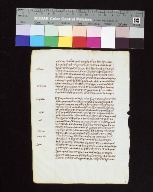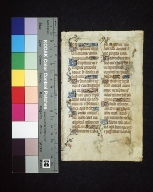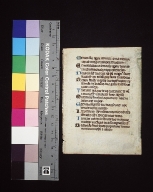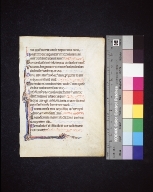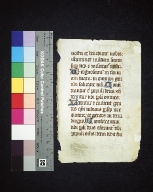|
REFINE
Browse All : Psalters - Illustrations and Manuscripts, Medieval and manuscript (documents) by Ege, Otto F. and Ege, Otto F.
1-8 of 8
Title
Psalter. Fragments.
Creator
Catholic Church
Summary
[Ms. This manuscript leaf is part of a collection of medieval manuscript leaves selected to illustrate the art of the manuscript during the period of its greatest development and influence. They have been taken from books written in various European scriptoria by Benedictine, Franciscan, Carthusian, Dominican, and other orders of monks. Many are enriched with handsome borders, initial letters, and line-endings rendered in color. Twenty-five are illuminated with burnished gold or silver. The texts include the Bible, various church service books, the writings of the Church fathers, and some of the Classics., In carolingian minuscule script, This text is from a special arrangment of the Psalms. Several Church Fathers made their own groupings for the Scriptures. Of these so-called "chains" the most famous is that of St. Thomas Aquinas. The author of the arrangement represented by this leaf is unknown. The scribe of the 12th century often came close to achieving perfection. The symmetry of his letters, the unerring accuracy of his practiced hand, and his ideals for letter forms have rarely been equaled and have never been surpassed. The words which were inserted in the margin are not corrections but were added as guides to the content of the page. This vellum leaf was created in France.]
Title
Psalter. Fragments.
Creator
Catholic Church
Summary
[Ms. This manuscript leaf is part of a collection of medieval manuscript leaves selected to illustrate the art of the manuscript during the period of its greatest development and influence. They have been taken from books written in various European scriptoria by Benedictine, Franciscan, Carthusian, Dominican, and other orders of monks. Many are enriched with handsome borders, initial letters, and line-endings rendered in color. Twenty-five are illuminated with burnished gold or silver. The texts include the Bible, various church service books, the writings of the Church fathers, and some of the Classics., In angular gothic script, Illuminated Psalters occur as early as the 8th century, and from the 9th to the beginning of the 14th century they predominate among illuminated manuscripts. About 1220 A.D., portable manuscript volumes supplanted the huge tomes favored in the preceding century. This change in size caused the creation of a more angular and compact script. In general, smaller initial letters were used, and writing was done in double columns. At this time the pendant tails of the initial letters are rigid or only slightly wavy, with a few leaves springing from the ends. Later, they became free scrolls, with luxurious foliage, and were extended into all the margins. The blue and lake (orange-red) color scheme with accents of white is a carry-over from the Westminster tradition which prevailed in the previous century. The solid line-filling ornaments at the ends of the verses were a new feature added in the second half of the 13th century. Silver and alloys of gold are used on this leaf. This vellum leaf was created in England.]
Title
Psalterium : fragment
Creator
Catholic Church
Summary
[Ms. This manuscript leaf is part of a collection of medieval manuscript leaves selected to illustrate the art of the manuscript during the period of its greatest development and influence. They have been taken from books written in various European scriptoria by Benedictine, Franciscan, Carthusian, Dominican, and other orders of monks. Many are enriched with handsome borders, initial letters, and line-endings rendered in color. Twenty-five are illuminated with burnished gold or silver. The texts include the Bible, various church service books, the writings of the Church fathers, and some of the Classics., In angular gothic script., This small Psalter leaf illustrates the fact that, although skilled scribes were available in many monasteries in the 13th century, some of the monks who attempted to apply and burnish the gold leaf were still struggling with many problems of illumination. The famous treatise De Arte illuminandi and Cennino Cennini's Trattato were both of later date. These works gave directions on how to prepare and use the glair of egg, Armenian bole, stag-horn glue, and hare's foot, and on how to burnish the gold with a suitable wolf's tooth. These books might not have been too helpful, however, for the}author of the De Arte Illuminandi adds, "Since experience is worth more in all this than written documents, I am not taking any special pains to explain what I mean." This vellum leaf was created in Flanders.]
Title
Psalterium: fragment
Creator
Catholic Church
Summary
[Ms. This manuscript leaf is part of a collection of medieval manuscript leaves selected to illustrate the art of the manuscript during the period of its greatest development and influence. They have been taken from books written in various European scriptoria by Benedictine, Franciscan, Carthusian, Dominican, and other orders of monks. Many are enriched with handsome borders, initial letters, and line-endings rendered in color. Twenty-five are illuminated with burnished gold or silver. The texts include the Bible, various church service books, the writings of the Church fathers, and some of the Classics., In angular gothic script, The line ending of a fish, elongated or shortened as the space required, and the grinning expression of the fish emblem have in some book circles given these German Psalters the nickname "Laughing Carp" Psalters. The fish, as is well known, was one of the earliest and most common symbols for Christ. An early acrostic, IESOUS CHRISTOS THEOU HUIOS SOTER (Jesus Christ, son of God, Savior), is based on the letters in the Greek word for fish, ICHTHUS. The lozenge heads on top of many of the vertical pen strokes are characteristic of German manuscripts. This vellum leaf was created in Germany.]
Title
Psalterium: fragment
Creator
Catholic Church
Summary
[Ms. This manuscript leaf is part of a collection of medieval manuscript leaves selected to illustrate the art of the manuscript during the period of its greatest development and influence. They have been taken from books written in various European scriptoria by Benedictine, Franciscan, Carthusian, Dominican, and other orders of monks. Many are enriched with handsome borders, initial letters, and line-endings rendered in color. Twenty-five are illuminated with burnished gold or silver. The texts include the Bible, various church service books, the writings of the Church fathers, and some of the Classics., In angular gothic script., Small Psalters of this period are comparatively rare, since Psalters were used primarily in the church services and not by the layman. Here, the letters and ornament still retain all the rigidity of the previous century and give no indication of the rounder type of letter or any beginning of the interest in nature that characterized the work of the scribes in France. The filigree decoration, as well as the line-finishing elements, show, however, more creative freedom than either the initial or the text letters. The small burnished gold letters display considerable skill on the part of the illuminator, for it is difficult to control small designs in the gesso used as a base for the raised gold leaf. This vellum leaf was created in Flanders.]
Title
Psalterium: fragment
Creator
Catholic Church
Summary
[Ms. This manuscript leaf is part of a collection of medieval manuscript leaves selected to illustrate the art of the manuscript during the period of its greatest development and influence. They have been taken from books written in various European scriptoria by Benedictine, Franciscan, Carthusian, Dominican, and other orders of monks. Many are enriched with handsome borders, initial letters, and line-endings rendered in color. Twenty-five are illuminated with burnished gold or silver. The texts include the Bible, various church service books, the writings of the Church fathers, and some of the Classics., In gothic script, The psalter with its one hundred and fifty psalms is the best collection of religious lyrics which the world possesses. It is no wonder, therefore, that it forms an important part of so many medieval manuscripts. The Psalms are found not only in manuscripts of the bible, but also in Missals, Breviaries, and Books of Hours; and, as they had to be memorized by the priests, they were also transcribed separately. In the earlier periods there was generally a harmonious unity between the spirit of the ornament and the character of the writing. This unity is exemplified in this leaf. The three lobed, gracefully drawn symmetrical fronds of leaves in the ornament are usually accepted without question as representing the ivy plant. In the Middle Ages many magical and medicinal qualities were attributed to this plant. Unfortunately, fire and water, mice and men have in the course of the centuries often left their damaging marks on manuscript leaves. Some pages of this manuscript book show the effect of having been exposed to dampness. This vellum leaf was created in France.]
Title
Psalterium: fragment
Creator
Catholic Church
Summary
[Ms. This manuscript leaf is part of a collection of medieval manuscript leaves selected to illustrate the art of the manuscript during the period of its greatest development and influence. They have been taken from books written in various European scriptoria by Benedictine, Franciscan, Carthusian, Dominican, and other orders of monks. Many are enriched with handsome borders, initial letters, and line-endings rendered in color. Twenty-five are illuminated with burnished gold or silver. The texts include the Bible, various church service books, the writings of the Church fathers, and some of the Classics., In Rotunda book hand; square notations, This Psalter was written by Carthusian monks. Of all the orders in the Carthusian was the smallest and most austere. The membership never exceeded one per cent of those enrolled in the combined monastic orders. The Carthusians were frequently hermits, and manuscripts written by them are rare. The rotunda book hand used in this leaf is representative of the general excellence maintained by Italian scribes at the time when printing was being introduced into their country. The simple melody for the Psalms apparently was added at a somewhat later date. Close observation of the initial letters will frequently reveal a small black letter inserted as a guide for the monk who later added the color initial. The use of two guide lines for the lettering is unusual. Ordinarily one line, below the writing, was deemed sufficient. The lines were drawn with a stylus composed of two parts lead and one part tin. This leaf was created in Italy.]
Title
Psalterium: fragment
Creator
Catholic Church
Summary
[Ms. This manuscript leaf is part of a collection of medieval manuscript leaves selected to illustrate the art of the manuscript during the period of its greatest development and influence. They have been taken from books written in various European scriptoria by Benedictine, Franciscan, Carthusian, Dominican, and other orders of monks. Many are enriched with handsome borders, initial letters, and line-endings rendered in color. Twenty-five are illuminated with burnished gold or silver. The texts include the Bible, various church service books, the writings of the Church fathers, and some of the Classics., In angular gothic script; gothic notation, This leaf from the Book of Psalms was written in the Benedictine monastery of St. Stephan in Würzburg and dated 1499 A.D. The book hand closely resembles the fine early gothic types called lettre de forme and used by Fust and Schoeffer in their superb Psalter issued in 1457. It is known that these printers also used this type to print the Canon of the mass which was frequently sold as a replacement for the soiled and worn out manuscript pages of that text. A close examination indicates that the scribe apparently tried to imitate printing type characters in many instances. In just the same way, the first printers had copied in their designs the current local book hand. The line of music giving the "free" melody of the psalm here retains the early XIIth century staff, with the C-line colored yellow and the F-line red. These note forms are frequently called Hufnagelschrift or horse-shoe nail notation because of their resemblance to hobnails. This vellum leaf was created in Germany.]
1-8 of 8
|
